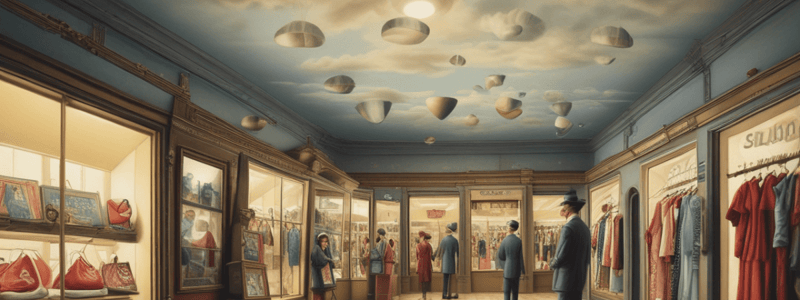Podcast
Questions and Answers
What is the primary purpose of visual merchandising?
What is the primary purpose of visual merchandising?
- Increasing foot traffic
- Reinforcing brand identity (correct)
- Creating a memorable shopping experience
- Enhancing customer satisfaction
Which aspect of visual merchandising can connect with customers on a deeper level?
Which aspect of visual merchandising can connect with customers on a deeper level?
- Strategic window displays
- Effective store layout
- Signage and displays placement
- Conveying brand values (correct)
How do well-designed window displays contribute to retail success?
How do well-designed window displays contribute to retail success?
- Promoting impulse purchases
- Enhancing customer service
- Guiding customers through the store
- Increasing foot traffic (correct)
What role does store layout play in retail strategies?
What role does store layout play in retail strategies?
How do strategic placement of products and displays influence customer behavior?
How do strategic placement of products and displays influence customer behavior?
How can a well-trained customer service representative enhance customer satisfaction and loyalty?
How can a well-trained customer service representative enhance customer satisfaction and loyalty?
What is the primary purpose of visual displays in retail?
What is the primary purpose of visual displays in retail?
How do marketing strategies contribute to establishing brand preference among consumers?
How do marketing strategies contribute to establishing brand preference among consumers?
Which technique can be utilized by visual merchandisers to guide customers through the store?
Which technique can be utilized by visual merchandisers to guide customers through the store?
What role do visual display techniques play in converting potential customers into repeat customers?
What role do visual display techniques play in converting potential customers into repeat customers?
Flashcards are hidden until you start studying
Study Notes
Retail Strategies: Visual Merchandising, Customer Service, Visual Display Techniques, Marketing
Retail strategies encompass a variety of tactics designed to increase sales, enhance customer satisfaction, and create a memorable shopping experience. Four key elements of retail strategies include visual merchandising, customer service, visual display techniques, and marketing. Let's delve into each of these aspects in more detail.
Visual Merchandising
Visual merchandising is the art and science of presenting products in a visually appealing and strategic manner to drive sales and enhance the shopping experience. It plays a crucial role in reinforcing a retailer's brand identity by creating a consistent and cohesive visual merchandising strategy. Visual merchandising can evoke emotions, convey brand values, and connect with customers on a deeper level through visual storytelling.
Window displays are a critical aspect of visual merchandising, serving as the first point of contact between the store and potential customers. A well-designed window display can instantly grab attention and draw customers into the store, increasing foot traffic and potential sales. Inside the store, an effective store layout can guide customers through the store, create a sense of flow, and encourage them to explore different areas. Strategic placement of products, signage, and displays can influence customer behavior, such as directing them towards high-margin items or promoting impulse purchases.
Customer Service
Customer service is a fundamental aspect of retail strategies. It involves interacting with customers in a friendly and efficient manner to handle their queries, concerns, and complaints. By providing excellent customer service, retailers can enhance customer satisfaction and loyalty. Additionally, customer service can be enhanced by utilizing visual merchandising skills. For example, a well-trained customer service representative can use visual cues to guide customers through the store, making them feel more comfortable and engaged, leading to increased sales and customer satisfaction.
Visual Display Techniques
Visual displays are a key component of visual merchandising. They can range from simple signage to elaborate window displays. Visual displays are designed to attract customers' attention, communicate brand values, and influence customer behavior. For example, a retailer might use props, lighting, and imagery to create a visual story of adventure and exploration, evoking feelings of excitement, freedom, and inspiration in customers. The proper use of visual merchandising is a useful tool to convert potential customers into repeat customers.
Marketing
Marketing is the process of promoting and selling products or services. In retail, marketing strategies often include advertising, promotions, and public relations. Marketing is closely linked to visual merchandising, as visual displays are often used to promote products and services. Additionally, marketing can be used to communicate brand values and establish brand preference among consumers.
In conclusion, retail strategies encompass a variety of elements, including visual merchandising, customer service, visual display techniques, and marketing. By utilizing these strategies effectively, retailers can create an immersive shopping experience that leaves a lasting impact on customers, leading to increased sales and customer satisfaction.
Studying That Suits You
Use AI to generate personalized quizzes and flashcards to suit your learning preferences.



